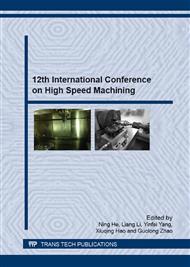[1]
L.H. Meng, N. He, Y.F. Yang, B. Rong, Method for Measuring Residual Stresses Induced by Boring in Internal Surface of Tube and Its Validation with XRD Method, Transactions of Nanjing University of Aeronautics and Astronautics. 31(2014) 508-514.
Google Scholar
[2]
N. Grossi, L. Sallese, A. Scippa, G. Campatelli, Speed-varying cutting force coefficient identification in milling, http: /dx. doi. org/10. 1016/j. precisioneng. 2015. 04. 006.
DOI: 10.1016/j.precisioneng.2015.04.006
Google Scholar
[3]
W.A. Kline, R.E. Devor, R. Lindberg, The prediction of cutting forces in end milling with application to cornering cuts, International Journal of Machine Tool Design and Research. 21 (1982) 7-22.
DOI: 10.1016/0020-7357(82)90016-6
Google Scholar
[4]
S.B. Wang, L. Geng, Y.F. Zhang, K. Liu, T.E. Ng, Cutting force prediction for five-axis ball-end milling considering cutter vibrations and run-out, International Journal of Mechanical Sciences, http: /dx. doi. org/10. 1016/j. ijmecsci. 2015. 04. 007.
DOI: 10.1016/j.ijmecsci.2015.04.007
Google Scholar
[5]
C. Liu, X. Ai, Z.Q. Liu, Y. Wan, Modeling and analysis on cutting force and surface roughness in turning of high temperature alloy GH2132, Tool Engineering. 10 (2009) 19-21.
Google Scholar
[6]
C. Liu, X. Ai, Z.Q. Liu, Y. Wan, Wear Mechanism of Cemented Carbide Tool in High Speed Machining Iron-based Superalloy GH2132, Transactions of the Chinese Society for Agricultural Machinery. 11 (2009) 240-244.
Google Scholar
[7]
B.F. Li, X.Y. Wang, Q.X. Yu, S.Q. Pang, Experimental research on new coated cutting tool for turning high temperature alloy GH2132, New technology and New Process. 06 (2010) 49-52.
Google Scholar
[8]
Z.X. Feng, Research on Cutting the Iron-based Superalloy with the Coated Carbide tools, Dalian University of Technology. (2013).
Google Scholar
[9]
M. Alauddin, E. Baradie, M.S.J. Hashmi, Modeling of cutting force in end milling Inconel 718, Journal of Materials Processing Tech. 58 (1996) 100-108.
DOI: 10.1016/0924-0136(95)02113-2
Google Scholar
[10]
D.K. Aspinwall, R.C. Dewes, E.G. Ng, C. Sage, S.L. Soo , The influence of cutter orientation and workpiece angle on machinability when high-speed milling Inconel 718 under finishing conditions, International Journal of Machine tools & Manufacture. 47(2007).
DOI: 10.1016/j.ijmachtools.2007.04.007
Google Scholar
[11]
R.S. Pawade, S.S. Joshi, P.K. Brahmankar, M. Rahman, An investigation of cutting forces and surface damage in high-speed turning of Inconel 718, Journal of Materials Processing Technology. (2007) 139-146.
DOI: 10.1016/j.jmatprotec.2007.04.049
Google Scholar
[12]
H.R. Krain, A.R.C. Sharman, K. Ridgway, Optimization of tool life and productivity when end milling Inconel 718TM, Journal of Materials Processing Technology. 189 (2007) 153-161.
DOI: 10.1016/j.jmatprotec.2007.01.017
Google Scholar
[13]
D.L. Wang, Z.F. Xun, J.Y. Pang, A.Y. Sun, C. Zhang, Experimental Study on Machinability of Ni-Base Superalloy K24, Chinese Journal of Mechanical Engineering. S1 (2002) 190-193.
Google Scholar
[14]
W.C. Zhou, Y.F. Yang, L. Li, M. Zhao, W. Zhao, Experimental study on milling force of high-temperature alloy GH706, Tool Engineering. 08 (2014) 22-25.
Google Scholar
[15]
Editorial Committee of the China aviation material handbook, China aviation material handbook (second volume), Standards Press of China, Beijing, (2001).
Google Scholar
[16]
G. Taguch, The experimental design method (I), China Machine Press, Beijing, (1987).
Google Scholar
[17]
Information on http: /www. walter-tools. com.
Google Scholar


